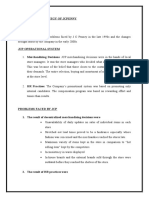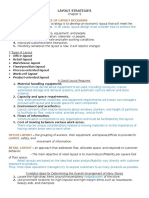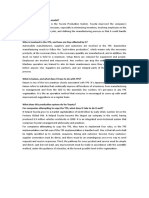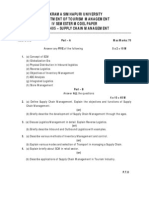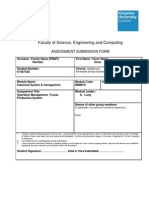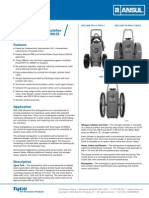Professional Documents
Culture Documents
Toyota Production System As A Benchmark To Improve Business Productivity
Original Title
Copyright
Available Formats
Share this document
Did you find this document useful?
Is this content inappropriate?
Report this DocumentCopyright:
Available Formats
Toyota Production System As A Benchmark To Improve Business Productivity
Copyright:
Available Formats
Volume 3, Issue 1, January – 2018 International Journal of Innovative Science and Research Technology
ISSN No:-2456 –2165
Toyota Production System as a Benchmark to Improve
Business Productivity
Athira Krishna, Dr. Sini V Nair,
Student, Trimester 2, Operations Management, Master of Assistant Professor, College of Engineering Trivandrum,
Business Administration, College of Engineering School of Management, Affiliated to APJ Abdul Kalam
Trivandrum, School of Management, Affiliated to APJ Technological University (KTU)
Abdul Kalam Technological University (KTU)
Abstract:-The paper aims to prove that Toyota Production Toyota’s success and recent dominance in the auto industry.
System is the best benchmarking system to improve the The Lean formula is well-published, but every day is filled
efficiency and productivity of business. The Toyota with countless make-or-break decisions. And each of those
Production System (TPS) is an integrated socio-technical decisions takes hard work and a gut check to make the right
system, developed by Toyota that comprises its one. Tracking down the source of a problem and fixing it for
management philosophy and practices. The TPS organizes good may take hours of work and lots of frustration.
manufacturing and logistics for the automobile Overcoming this through lean was the success of Toyota.
manufacturer, including interaction with suppliers and
customers. The system is a major precursor of the more TPS improves quality in products and processes. Overall, TPS
generic "lean manufacturing". Taiichi Ohno and Eiji uses several lean methods to help reduce errors and improve
Toyoda, Japanese industrial engineers, developed the quality: Kaizen, 5S, 5 Whys, and Poka-Yoke. These tools help
system between 1948 and 1975.Originally called "just-in- workers spot inefficiencies, errors, or potential defects and
time production", it builds on the approach created by the empowers them to stop the assembly line so that defects are
founder of Toyota, Sakichi Toyoda, his son Kiichiro not included in the final product. TPS reduces waste,
Toyoda, and the engineer Taiichi Ohno. The principles increasing efficiency and reducing costs. The high-quality and
underlying the TPS are embodied in The Toyota Way. cost-competitive products Toyota produces are directly linked
Toyota’s supplier development practises are analysed. The to Toyota’s ability to reduce waste throughout the production
competitiveness of Toyota and the source of Toyota’s process. Just-In-Time (JIT), Kanban, Taki-Time, and Kaizen
competitive strength and the way in which Toyota can be are used to spot waste. Areas that have wasted movement,
used for effective benchmarking is verified. The overproduction, underproduction, inefficient transportation,
applicability of lean operation in retail pricing and unnecessary inventory, and defects are identified and
operation strategy along with the strategies that helped to improved until waste is eliminated. TPS improves customer
increase the capacity through TPS is evaluated for satisfaction by providing products that are free of defects. TPS
improving efficiency in production. For this, a mix of succeeds because it puts the customer first. The company’s
strategic methods are adopted through TPS by reducing zero-defect policy and continuous effort to reduce costs
the cost of product and judicious use of resources thereby enables the company to deliver quality at a price customers
playing the role of a responsible corporate citizen. can afford. TPS improves all aspects of safety for employees
and customers. TPS is a safety-conscious system that works to
Keywords: Kaizen, Kanban, 5S, JIT, Taki-Time, Poka-Yoke. reduce risks in the workplace as well as those found on the
road. 5S helps employees spot and eliminate hazards, while
I. INTRODUCTION Kaizen enables employees to stop the production line and
eliminate errors that may increase risks while driving. Toyota
The Toyota Production System (TPS), the main source for always strives to retain their benchmarking status. Hence it
Lean programmes , is the universally applicable and accepted can be used as a standard to improve business productivity.
system that has proven the test of time in improving business
productivity. The roots of TPS were formed with the
establishment of the Toyota Motor Company by Kiichiro
Toyoda in 1937 and the Honsha Plant being built in 1938. To
some, Toyota might seem surprisingly open with its Lean TPS
information. After all, Lean TPS is the primary reason for
IJISRT18JA60 www.ijisrt.com 189
Volume 3, Issue 1, January – 2018 International Journal of Innovative Science and Research Technology
ISSN No:-2456 –2165
II. LITERATURE REVIEW competitive in the market. The following are the questions and
answers that is discussed in this article,
According to Marksberry (2012), the paper uses a new method
for analyzing Toyota’s supplier development practices by • Fit and finish-Audi
mathematically representing and analyzing Toyota’s • Operating System Benchmark- Toyota
organizational documents. • Flexibility-Honda
• Interior-Volkswagen
Toyota production system (TPS) is one of the most
benchmarked business improvement strategies in modern Thus the article is very useful in comparing the various
industry. It is also important to how Toyota replicates TPS at benchmarking criterion for different brands which can help
suppliers. The purpose of this paper is to investigate the to improve the quality and productivity of business.
evolution of TPS and its in-house capabilities by evaluating
organizational documents using latent semantic analysis The article Integration of Lean Operation and Pricing Strategy
(LSA). The findings shows that Toyota targets processes, in Retail by Noda (2015) clarify whether lean can be
rather than whole systems, in assisting Suppliers Toyota’s successfully applied to retailing and how to develop a
approval does encourage minor day-to-day kaizen. Finally, competitive advantage by introducing lean to retailing. The
this work reports that the Toyota Way for suppliers does not study provides a better understanding of lean operation and
have to be adopted by suppliers, but does represent “A Way” stable pricing such as everyday low price for developing an
to interact with suppliers to drive both culture and productivity alternative business model to successfully compete with large
Simultaneously. retailers. It was found that lean can be successfully applied to
retailing and stable pricing becomes a driver for successful
Fujimoto (2012) in his article, the evolution of Production implementation of lean operation. The study stresses
systems: .Exploring the sources of Toyota’s competitiveness, importance of integration of marketing and operation as a
analyses the formation process the sources of Toyota’s corporate strategy to develop a suggested model.
Competitive Strength. The present paper explores both the
functions and origins of the Toyota-style manufacturing Lean Operation: “Lean production is generally described
system simultaneously. It concludes that the source of from two points of view, either from a philosophical
Toyota’s competitive strength can be explained in part by the perspective related to guiding principles and overreaching
“product architecture” perspective and also shows that goal , or from the practical perspective of a set of management
manufacturing contains three layers of organizational practices, tools, or techniques that can be observed directly .
capability: manufacturing (monozukuri) capability, “The main objective is to eliminate waste by reducing or
improvement (kaizen) capability, and evolutionary capability. minimizing supplier, customer, and internal variability. Lean
This is done through a generic analytical framework that is production not only as a production system, but also as an
applicable to a wide range of different industries. integrated system in a whole business structure. To clarify the
“Competitiveness,” uses the concepts of “closed” and “open” factors of lean operation in retail is of importance where study
to indicate the level of competition within the industry, on low cost was mainly focused by lean production. The three
whether there is international competition, whether the aspects to transform its business model includes marketing
industry is regulated or protected by the government. Products transformation, operational transformation and support
are typically developed by a “mix and match” and designed business transformation.
for generic use across different products where significant
effort upfront to ensure the component design is applicable to However, it is said that it is difficult for the retail industry to
many different products and models, and in this way introduce lean. Moreover, in manufacturing industry,
manufacturers are saved a great deal of effort coordinating production process is managed smoothly with little variation.
their design and assembly of finished products. “Production This model can improve business performance by creating
expansion accompanied by model diversification” was a price advantage for sales growth and cost advantage for low
distinguishing characteristic of the post war Japanese auto cost.
industry.
This article Strategies for increasing productivity in
An article by Vasilash (2003), Who do you benchmark? Some production systems by Pergher et al (2013) aims at a set of
answers from GM manufacturing, the highlights answers to strategies can be adopted to increase the capacity constraints
many questions in such a way that it shows perfect examples in production systems, when the constraint is internal the
of each keyword in the question. Benchmarking is done on the factory and not is in the market. To serve this purpose will be
basis of setting those answers as the base standard for presented strategies that includes theory of Constraints, Lean
comparison. IT highlights “Take your future in a new Manufacturing and Total Productive Maintenance. The
direction”. As said by TROY a Clarke, Benchmarking is the objective set of practical strategy that can be used to increase
most powerful tool that exists. And hence it is better to have a the capacity and productivity of production systems according
strong understanding of what others are doing to be
IJISRT18JA60 www.ijisrt.com 190
Volume 3, Issue 1, January – 2018 International Journal of Innovative Science and Research Technology
ISSN No:-2456 –2165
to the needs of each manufacturing system. The strategies Strategy 16: Conduct analysis of restriction from seven losses
include 25 strategies that help to eliminate bottlenecks and in the TPS is analyzed.
ensure continuous performance improvement. The strategies
include: Strategy 17: Conduct analysis of improvement in the
ergonomic point of view of the operation. Time and motion
Strategy 1: Eliminate all periods of time lost in the bottleneck. study, derived from scientific management are recommended.
An hour lost on bottle neck is an hour lost in the whole system
and being bottleneck should operate 24 hours a day. Strategy 18: Make improvements in the productive system as a
whole.
Strategy 2: Improved processing times per unit. Perform
continuous improvement actions in the working methods and Strategy 19: Evaluate the application of first principle of TOC
the optimum use of the potential of the equipment. that says to not to focus in the balancing of the capacities and
yes to focus the synchronization of the flow.
Strategy 3: Deliver improvements in the power system
engineer. The goal should be to synchronize the timing of food Strategy 20: Evaluate the application of second principle TOC
resources with the speed of processing of the resource itself, that says the value marginal of the time in the resource
seeking continuous system flow. bottleneck is equal to the rate of profit of the products
processed for the bottleneck.
Strategy 4: Improve the quality control system.
Strategy 21: Apply the third principle TOC that says the
Strategy 5: Making the contracting out or outsourcing of work marginal value of time in a resource bottleneck is not
from the bottle. In other words, implies subcontract or negligible.
outsource in order to purchase additional capacity.
Strategy 22: To consider the fourth principle of TOC that
Strategy 6: Buy additional capacity. statements that the level of use of a resource pass is not
controlled for the restriction of the system.
Strategy 7: Relocation of the operations previously performed
in the neck for other non-bottleneck machines that are Strategy 23: Apply the fifth principle of TOC that statement
operating with a surplus of capacity. The goal this point is to the resources must be used and not only activated. The use
divide the operation of the bottleneck in smaller sub- concept mentions the activation to it of resources that
operations and redistribute them. contribute positively for the performance of the company that
is to generate profits for the Company.
Strategy 8: Make improvements in the maintenance of
machine bottleneck and critical system resources. Strategy 24: Apply the sixth principle indeed the lot of
transference does not need to be, and many times do not have
Strategy 9: Conduct analysis and layout changes. to be, equal to the lot of process.
Strategy 10: Synchronize the system from the bottleneck and Strategy 25: Apply the seventh principle that says the process
protects the capacity of the bottleneck using the buffer batch should be variable. The process batch should be variable
immediately prior to the drum. along the route of manufacture and over time.
Strategy 11: Raise the TEEP of the resource bottleneck. His It is reasonable to assume that the lot in process can vary
discussion is central to the capacity calculation because it throughout the route of manufacture due to the impact of the
determines the theoretical and not practical capacity of the statistical fluctuations of the system and the different
equipment. capacities of the resources.
Strategy 12: Increase the availability (A) of the resource A single case study research in one of the plant of Toyota
bottleneck. Motor Corporation located in the Aichi province in Japan
(Eisenhardth , 1989; Yin, 2003). Within this context, we
Strategy 13: Oriented approach to product development. studied the practice of process improvement. The reason to
choose this company is due to the fact that Toyota Production
Strategy 14: Modify existing products to reduce the processing System (TPS) was not easy to replicate in the occidental
time. automobile’s industry (Schroeder & Robinson, 1991; Spear &
Bowen, 1999). Some simple arguments point out that the
Strategy 15: Conduct analysis and improvement of the reason for Toyota Production System’s success lies in its
bottleneck applying the sub systems and techniques of TPS. cultural roots. Meanwhile authors argued that this particular
characteristic (the TPS) can be considered as a set of
IJISRT18JA60 www.ijisrt.com 191
Volume 3, Issue 1, January – 2018 International Journal of Innovative Science and Research Technology
ISSN No:-2456 –2165
capabilities which generate a strong competitive advantage IV. CONCLUSION
(Fujimoto, 1994; Takeyuki, 1995)
All the key factors that are the reasons for the success of
In the paper Responsible Operations through Materials' Toyota and those companies who can be benefitted by
Conservation – An Overview of Techniques and Trends, adopting the Toyota Production System has been analyzed.
Rajashekharaiah (2015) initially brief on operations and The Competitive strength and the mix of strategies resulting in
manufacturing priorities which includes all the issues related development of unique effective ideas that can improve the
and how the changes happened in the competition over time business productivity is evident in this paper. TPS has been
across the countries. The main strategy is to adopt to a best one of the major reasons behind the success of many
practice by mixing various selected strategies for achieving companies. Its adoption has helped many companies to
the goal. The aim include reduction in the total cost of the overcome defects, automation, quality assurance, timely
product by finding out the various probable reasons that may delivery, good retail and good relationship with suppliers.
lead to price hike, re-examination of material strategies to Many companies are adapting to the TPS way, but the real
bring down the cost and reduce the consumption of raw gain is in adopting the success of the system developed by
materials. Hence this paper highlights practices, approaches TPS. The aim of the Toyota production systems is to provide
and techniques to reduce consumption of materials and thus the customers with highest quality products at the lowest
become a responsible corporate citizen. It also includes a list possible cost. The production concepts incorporate quality at
of popular strategies that focus on material conservation. Such each production stage. The Just in Time approach seeks to get
kind of a study would warrant strategies to appeal to conserve the right information about the market demand and the
materials by a mix of strategies which helps in saving production is adapted to the demand. The JIT systems leads to
products of the nature like fast depleting ores, wood and efficient inventory systems and only the required quantities
petroleum products which helps to play the responsible are procured in the production systems. The Kanban systems
corporate citizen. enable the working of the JIT system by providing the
information about the raw materials and keep a check on
III. FINDINGS AND SUGGESTIONS quality. To ensure that the JIT system works, Toyota has
implemented systems to motivate employees and empower
Companies that pursue and emulate TPS best practices have them. The Toyota production system is very efficient that has
seen much success as a result of this highly effective made Toyota a competitive and profitable company. Since the
manufacturing philosophy. Some of the benefits include: 1950s Toyota created the concept of continuous material flow,
process standardization and a pull system that is market
• Identify and enhance customer perceived value responsive. It took the company decades to refine the concepts
• Decrease waste and cost in the manufacturing process such as JIT and make the production system more functional.
• Improve product quality and on-time delivery The TPS is characterized by cross organizational planning and
• Develop a competitive world class manufacturing long term objectives. This production system relies on
operation technology and the integration of all manufacturing activities.
The focus on meeting customer needs made the TPS highly
The TPS is a system that has given companies a blueprint for successful the creation of the JIT philosophy allowed the
manufacturing excellence. Techniques such as Poka Yoke, company to eliminate wastages and inventory to make the
Kanban, and SMED are concrete well understood techniques company more profitable.
to minimize waste and eliminate errors, they are components
of the overall TPS. These techniques are not the definition of Toyota’s supplier network and supply chain is another source
TPS rather they are a result of TPS. By codifying and of the company’s competitive advantage. To conclude, the
understanding the relationship of manufacturing practices and result is a continuous stream of small changes that result in
end customer value TPS allowed Toyota to grow into a world ongoing improvements. Because the changes are small, they
class manufacturing company. The TPS model is simple on its can be quickly and economically implemented. Because they
surface; focus first on finding ways to improve in one area, are continuous, over a short period of time they'll add up to
then another, until every process or area has been considered, significant improvements.
and then think through connections among them to reduce
friction and inefficiencies. It is not just about moving faster,
but also improving quality and conservation of resources by
judiciously using them without any wastage.
IJISRT18JA60 www.ijisrt.com 192
Volume 3, Issue 1, January – 2018 International Journal of Innovative Science and Research Technology
ISSN No:-2456 –2165
REFERENCES
[1]. Kachwala, T. T., & Mukherjee, P. N. (2009). Operations
management andproductivity techniques. PHI Learning.
[2]. Liu, S., & Jiang, M. (2011). Providing Efficient Decision
Support for GreenOperations Management: An Integrated
Perspective. INTECH.
[3]. Najdawi, M. K., Chung, Q. B., & Salaheldin, S. I. (2008).
Expert systems for strategic planning in operations
management: a framework for executive decisions.
International Journal of Management and Decision
Making, 9(3), 310-327.
[4]. Marksberry, Phillip, Investigating “The Way” for Toyota
Suppliers, Benchmarking: An International Journal; 2012.
[5]. Fujimoto,Takahiro, , The Evolution of Production
systems: .Exploring the sources of Toyota’s
competitiveness, ISSN 1347-4464;2012.
[6]. Vasilash, Gary S, Why do you Benchmark?
ABI/INFORM Global; Mar 2003.
[7]. Rajashekharaiah, Jagadeesh, Responsible Operations
through Materials' Conservation. An Overview of
Techniques and Trends, International Journal of
Information, Business and Management; 2015
[8]. Noda , Taru,Lean Operation and Pricing Strategy in Retail
; (2015).
[9]. Pergher et al, Strategies for increasing productivity in
production systems, Independent Journal of Management
and Production, Mar 2014.
IJISRT18JA60 www.ijisrt.com 193
You might also like
- GuidewireClaimCenter Performance TestPlanDocument18 pagesGuidewireClaimCenter Performance TestPlanshanthan117No ratings yet
- Lab Report Experiment 5Document4 pagesLab Report Experiment 5Czarina mantuano100% (2)
- SCM Toyota Group10Document24 pagesSCM Toyota Group10ANKIT SHAH MBA IB 2018-20 (DEL)100% (1)
- ToyotaDocument2 pagesToyotajerrin jaisonNo ratings yet
- Evaluation of Manufacturing Strategy and Role of ITDocument9 pagesEvaluation of Manufacturing Strategy and Role of ITPavan R KulkarniNo ratings yet
- Honda Operational ManagmentDocument41 pagesHonda Operational ManagmentAnas Sajid100% (1)
- The Seven Domains Model - JabDocument27 pagesThe Seven Domains Model - JabpruthirajpNo ratings yet
- The Finance Director of Menendez Is Trying To Improve TheDocument1 pageThe Finance Director of Menendez Is Trying To Improve TheAmit Pandey50% (2)
- Turnaround Strategy of JcpennyDocument7 pagesTurnaround Strategy of Jcpennystolen_lovNo ratings yet
- Toyota Success RecipeDocument7 pagesToyota Success Recipeapi-3740973No ratings yet
- Decision Making in Finance For Production LinesDocument26 pagesDecision Making in Finance For Production LinesRahul NakheNo ratings yet
- Wheel Loader L50E: 2 EngineDocument4 pagesWheel Loader L50E: 2 EngineInjeletro Diesel100% (1)
- Critical Environmental Concerns in Wine Production An Integrative ReviewDocument11 pagesCritical Environmental Concerns in Wine Production An Integrative Reviewasaaca123No ratings yet
- Inventory Management Assignment "World Class Manufacturing" Submitted To Sir Raja KhalidDocument15 pagesInventory Management Assignment "World Class Manufacturing" Submitted To Sir Raja KhalidFatimah KhanNo ratings yet
- The Process: Business Engineering ProductDocument7 pagesThe Process: Business Engineering ProductAmiya MahatoNo ratings yet
- Strategic Layout Decisions for Optimal Space UtilizationDocument5 pagesStrategic Layout Decisions for Optimal Space UtilizationJc GappiNo ratings yet
- Managing Organisational ChangeDocument5 pagesManaging Organisational ChangeHera RachmahaniNo ratings yet
- JIT Principles Ford Motor Company Plastics Division CaseDocument7 pagesJIT Principles Ford Motor Company Plastics Division CaseMamta Bansal0% (1)
- Maxxi Report FinalDocument7 pagesMaxxi Report FinalDepanshu Gola100% (1)
- Why and Wherefores of Power System BlackoutsDocument6 pagesWhy and Wherefores of Power System BlackoutsmentongNo ratings yet
- Part # Is 0032192-70: Eldorado Eldorado Eldorado Eldorado National National National NationalDocument1 pagePart # Is 0032192-70: Eldorado Eldorado Eldorado Eldorado National National National NationalmnvijaybabuNo ratings yet
- A Profile of Toyota's Production SystemDocument1 pageA Profile of Toyota's Production SystemZhen WuNo ratings yet
- Focussed FactoryDocument13 pagesFocussed FactoryjcspaiNo ratings yet
- Hoshin KanriDocument2 pagesHoshin KanriBaron Francis100% (1)
- Achieving Sustainability Through Lean ProductionDocument7 pagesAchieving Sustainability Through Lean Productionomar salinasNo ratings yet
- ISM Toyota With Work FlowDocument9 pagesISM Toyota With Work FlowAvnit kumarNo ratings yet
- Assignment 5 - Capacity PlanningDocument1 pageAssignment 5 - Capacity Planningamr onsyNo ratings yet
- Case Study: Vodafone EgyptDocument2 pagesCase Study: Vodafone EgyptIslam Ayman Mashaly50% (2)
- Mumbai Dabbawala CaseDocument33 pagesMumbai Dabbawala CaseAbhijit DasNo ratings yet
- Is JIT Manufacturing The Right PrescriptionDocument1 pageIs JIT Manufacturing The Right PrescriptionjoannakamNo ratings yet
- Farmaid 4Document10 pagesFarmaid 4rohan2109No ratings yet
- Distinguish Between Production Management and Operation Management. What Is Production Management?Document13 pagesDistinguish Between Production Management and Operation Management. What Is Production Management?Desu mekonnenNo ratings yet
- Operations Management 1Document30 pagesOperations Management 1BalujagadishNo ratings yet
- Financial and Management Accounting Sample Exam Questions: MBA ProgrammeDocument16 pagesFinancial and Management Accounting Sample Exam Questions: MBA ProgrammeFidoNo ratings yet
- MARKET SEGMENTATION, TARGETING AND POSITIONING OF BGI BREWERIESDocument11 pagesMARKET SEGMENTATION, TARGETING AND POSITIONING OF BGI BREWERIESYared DemissieNo ratings yet
- Strategic Management Accounting Summary SampleDocument5 pagesStrategic Management Accounting Summary SampleGreyGordonNo ratings yet
- Questionnaire For Foundry Raw Material or Scrap MetalDocument8 pagesQuestionnaire For Foundry Raw Material or Scrap MetalMichelleNo ratings yet
- Economics Assign Mba 9Document34 pagesEconomics Assign Mba 9Dickson MdhlaloseNo ratings yet
- Caselet 1 Answers Operations ManagementDocument3 pagesCaselet 1 Answers Operations ManagementAmit KumarNo ratings yet
- Strategic Choices in Corporate Objectives, Compensation Systems and Competitive AdvantageDocument3 pagesStrategic Choices in Corporate Objectives, Compensation Systems and Competitive AdvantageXeenNo ratings yet
- Mission Flow DiagramDocument1 pageMission Flow DiagramAnees Ethiyil KunjumuhammedNo ratings yet
- Financial Management E BookDocument4 pagesFinancial Management E BookAnshul MishraNo ratings yet
- Case 1 ToyotaDocument5 pagesCase 1 Toyotapheeyona0% (1)
- Usha Martin University Exam Question Paper on HRMDocument5 pagesUsha Martin University Exam Question Paper on HRMAakash KrNo ratings yet
- Strategy Formulation of BSNLDocument9 pagesStrategy Formulation of BSNLriyasacademicNo ratings yet
- Consumer Behavior (for MBA) Solved Mcqs set 8Document7 pagesConsumer Behavior (for MBA) Solved Mcqs set 8tanmoy mandalNo ratings yet
- Balance Score CardDocument12 pagesBalance Score CardkPrasad8No ratings yet
- Mediating Role of Organizational Commitment On HR Practices and Turnover Intention Among ICT ProfessionalsDocument1 pageMediating Role of Organizational Commitment On HR Practices and Turnover Intention Among ICT Professionalsijaz ahmadNo ratings yet
- The Toyota Production SystemDocument10 pagesThe Toyota Production SystemKenrick IntanNo ratings yet
- CIB8942Document6 pagesCIB8942Shepherd NhangaNo ratings yet
- SCRIBD - 3M InnovationDocument5 pagesSCRIBD - 3M InnovationsumiannaNo ratings yet
- IV Sem MBA - TM - Supply Chain Management Model Paper 2013Document2 pagesIV Sem MBA - TM - Supply Chain Management Model Paper 2013vikramvsu0% (1)
- IFE MatrixDocument3 pagesIFE MatrixJan Gelera0% (1)
- Managing Bull Whip - SCM Case StudyDocument11 pagesManaging Bull Whip - SCM Case StudyKumara Raja100% (1)
- Fayol's 14 Principles of Management ExplainedDocument29 pagesFayol's 14 Principles of Management ExplainedImam RizaldiNo ratings yet
- Chapter 6Document13 pagesChapter 6Mariell Joy Cariño-Tan100% (1)
- Assignment-1 Portakabin Case Study Test QuestionsDocument1 pageAssignment-1 Portakabin Case Study Test QuestionskingofsuperstarNo ratings yet
- P and G Revised - G2Document11 pagesP and G Revised - G2Sambit BehuraNo ratings yet
- Assignment II - Case Study EvaluationDocument11 pagesAssignment II - Case Study Evaluationdevics1997No ratings yet
- Knowledge Management and Emotional Intelligence in OrganizationsDocument27 pagesKnowledge Management and Emotional Intelligence in OrganizationsSahil PrakashNo ratings yet
- Frumherji CaseDocument26 pagesFrumherji Casethisissick100% (2)
- Executive Summary Abu Dhabi CateringDocument22 pagesExecutive Summary Abu Dhabi CateringGhadoor Mmsk50% (2)
- Chapter 2Document31 pagesChapter 2saraNo ratings yet
- Analysis of Inventory Control With Material Requirement Planning MRP MethodDocument13 pagesAnalysis of Inventory Control With Material Requirement Planning MRP MethodInternational Journal of Innovative Science and Research TechnologyNo ratings yet
- Operation Management, Toyota Production SystemDocument19 pagesOperation Management, Toyota Production SystemOmar S. Hamdan100% (1)
- Toyota Production System Research PaperDocument8 pagesToyota Production System Research Papercaqllprhf100% (1)
- Securing Document Exchange with Blockchain Technology: A New Paradigm for Information SharingDocument4 pagesSecuring Document Exchange with Blockchain Technology: A New Paradigm for Information SharingInternational Journal of Innovative Science and Research TechnologyNo ratings yet
- The Effect of Time Variables as Predictors of Senior Secondary School Students' Mathematical Performance Department of Mathematics Education Freetown PolytechnicDocument7 pagesThe Effect of Time Variables as Predictors of Senior Secondary School Students' Mathematical Performance Department of Mathematics Education Freetown PolytechnicInternational Journal of Innovative Science and Research TechnologyNo ratings yet
- Perceived Impact of Active Pedagogy in Medical Students' Learning at the Faculty of Medicine and Pharmacy of CasablancaDocument5 pagesPerceived Impact of Active Pedagogy in Medical Students' Learning at the Faculty of Medicine and Pharmacy of CasablancaInternational Journal of Innovative Science and Research TechnologyNo ratings yet
- Formation of New Technology in Automated Highway System in Peripheral HighwayDocument6 pagesFormation of New Technology in Automated Highway System in Peripheral HighwayInternational Journal of Innovative Science and Research TechnologyNo ratings yet
- Supply Chain 5.0: A Comprehensive Literature Review on Implications, Applications and ChallengesDocument11 pagesSupply Chain 5.0: A Comprehensive Literature Review on Implications, Applications and ChallengesInternational Journal of Innovative Science and Research TechnologyNo ratings yet
- Exploring the Clinical Characteristics, Chromosomal Analysis, and Emotional and Social Considerations in Parents of Children with Down SyndromeDocument8 pagesExploring the Clinical Characteristics, Chromosomal Analysis, and Emotional and Social Considerations in Parents of Children with Down SyndromeInternational Journal of Innovative Science and Research TechnologyNo ratings yet
- Intelligent Engines: Revolutionizing Manufacturing and Supply Chains with AIDocument14 pagesIntelligent Engines: Revolutionizing Manufacturing and Supply Chains with AIInternational Journal of Innovative Science and Research TechnologyNo ratings yet
- The Making of Self-Disposing Contactless Motion-Activated Trash Bin Using Ultrasonic SensorsDocument7 pagesThe Making of Self-Disposing Contactless Motion-Activated Trash Bin Using Ultrasonic SensorsInternational Journal of Innovative Science and Research TechnologyNo ratings yet
- Beyond Shelters: A Gendered Approach to Disaster Preparedness and Resilience in Urban CentersDocument6 pagesBeyond Shelters: A Gendered Approach to Disaster Preparedness and Resilience in Urban CentersInternational Journal of Innovative Science and Research TechnologyNo ratings yet
- Enhancing the Strength of Concrete by Using Human Hairs as a FiberDocument3 pagesEnhancing the Strength of Concrete by Using Human Hairs as a FiberInternational Journal of Innovative Science and Research TechnologyNo ratings yet
- Natural Peel-Off Mask Formulation and EvaluationDocument6 pagesNatural Peel-Off Mask Formulation and EvaluationInternational Journal of Innovative Science and Research TechnologyNo ratings yet
- Teachers' Perceptions about Distributed Leadership Practices in South Asia: A Case Study on Academic Activities in Government Colleges of BangladeshDocument7 pagesTeachers' Perceptions about Distributed Leadership Practices in South Asia: A Case Study on Academic Activities in Government Colleges of BangladeshInternational Journal of Innovative Science and Research TechnologyNo ratings yet
- Handling Disruptive Behaviors of Students in San Jose National High SchoolDocument5 pagesHandling Disruptive Behaviors of Students in San Jose National High SchoolInternational Journal of Innovative Science and Research TechnologyNo ratings yet
- Safety, Analgesic, and Anti-Inflammatory Effects of Aqueous and Methanolic Leaf Extracts of Hypericum revolutum subsp. kenienseDocument11 pagesSafety, Analgesic, and Anti-Inflammatory Effects of Aqueous and Methanolic Leaf Extracts of Hypericum revolutum subsp. kenienseInternational Journal of Innovative Science and Research TechnologyNo ratings yet
- REDLINE– An Application on Blood ManagementDocument5 pagesREDLINE– An Application on Blood ManagementInternational Journal of Innovative Science and Research TechnologyNo ratings yet
- Placement Application for Department of Commerce with Computer Applications (Navigator)Document7 pagesPlacement Application for Department of Commerce with Computer Applications (Navigator)International Journal of Innovative Science and Research TechnologyNo ratings yet
- Optimization of Process Parameters for Turning Operation on D3 Die SteelDocument4 pagesOptimization of Process Parameters for Turning Operation on D3 Die SteelInternational Journal of Innovative Science and Research TechnologyNo ratings yet
- Advancing Opthalmic Diagnostics: U-Net for Retinal Blood Vessel SegmentationDocument8 pagesAdvancing Opthalmic Diagnostics: U-Net for Retinal Blood Vessel SegmentationInternational Journal of Innovative Science and Research TechnologyNo ratings yet
- Adoption of International Public Sector Accounting Standards and Quality of Financial Reporting in National Government Agricultural Sector Entities, KenyaDocument12 pagesAdoption of International Public Sector Accounting Standards and Quality of Financial Reporting in National Government Agricultural Sector Entities, KenyaInternational Journal of Innovative Science and Research TechnologyNo ratings yet
- A Curious Case of QuadriplegiaDocument4 pagesA Curious Case of QuadriplegiaInternational Journal of Innovative Science and Research TechnologyNo ratings yet
- A Knowledg Graph Model for e-GovernmentDocument5 pagesA Knowledg Graph Model for e-GovernmentInternational Journal of Innovative Science and Research TechnologyNo ratings yet
- Machine Learning and Big Data Analytics for Precision Cardiac RiskStratification and Heart DiseasesDocument6 pagesMachine Learning and Big Data Analytics for Precision Cardiac RiskStratification and Heart DiseasesInternational Journal of Innovative Science and Research TechnologyNo ratings yet
- Forensic Evidence Management Using Blockchain TechnologyDocument6 pagesForensic Evidence Management Using Blockchain TechnologyInternational Journal of Innovative Science and Research TechnologyNo ratings yet
- Analysis of Financial Ratios that Relate to Market Value of Listed Companies that have Announced the Results of their Sustainable Stock Assessment, SET ESG Ratings 2023Document10 pagesAnalysis of Financial Ratios that Relate to Market Value of Listed Companies that have Announced the Results of their Sustainable Stock Assessment, SET ESG Ratings 2023International Journal of Innovative Science and Research TechnologyNo ratings yet
- Pdf to Voice by Using Deep LearningDocument5 pagesPdf to Voice by Using Deep LearningInternational Journal of Innovative Science and Research TechnologyNo ratings yet
- Improvement Functional Capacity In Adult After Percutaneous ASD ClosureDocument7 pagesImprovement Functional Capacity In Adult After Percutaneous ASD ClosureInternational Journal of Innovative Science and Research TechnologyNo ratings yet
- Fruit of the Pomegranate (Punica granatum) Plant: Nutrients, Phytochemical Composition and Antioxidant Activity of Fresh and Dried FruitsDocument6 pagesFruit of the Pomegranate (Punica granatum) Plant: Nutrients, Phytochemical Composition and Antioxidant Activity of Fresh and Dried FruitsInternational Journal of Innovative Science and Research TechnologyNo ratings yet
- Food habits and food inflation in the US and India; An experience in Covid-19 pandemicDocument3 pagesFood habits and food inflation in the US and India; An experience in Covid-19 pandemicInternational Journal of Innovative Science and Research TechnologyNo ratings yet
- Severe Residual Pulmonary Stenosis after Surgical Repair of Tetralogy of Fallot: What’s Our Next Strategy?Document11 pagesSevere Residual Pulmonary Stenosis after Surgical Repair of Tetralogy of Fallot: What’s Our Next Strategy?International Journal of Innovative Science and Research TechnologyNo ratings yet
- Scrolls, Likes, and Filters: The New Age Factor Causing Body Image IssuesDocument6 pagesScrolls, Likes, and Filters: The New Age Factor Causing Body Image IssuesInternational Journal of Innovative Science and Research TechnologyNo ratings yet
- Transmission ErrorDocument7 pagesTransmission ErrorTapas JenaNo ratings yet
- Ansul Wheeled RedLine 150lb F-2002046Document4 pagesAnsul Wheeled RedLine 150lb F-2002046German Duvan HernandezNo ratings yet
- FST DFS Ge-EgdDocument5 pagesFST DFS Ge-EgdEric DunnNo ratings yet
- PilotstarD AP02-S01 Mar09Document168 pagesPilotstarD AP02-S01 Mar09Dharan NarayananNo ratings yet
- Ejercicios Propuestos Temas Hasta Primer PrevioDocument2 pagesEjercicios Propuestos Temas Hasta Primer PrevioJuan De DiosNo ratings yet
- Premium Swab Rigs Since 1925Document8 pagesPremium Swab Rigs Since 1925fabricio3fabricio-1No ratings yet
- Introduction To Manufacturing Engineering: Lecturer: Ass - Prof.Dr. Nguyen Tien DuongDocument14 pagesIntroduction To Manufacturing Engineering: Lecturer: Ass - Prof.Dr. Nguyen Tien DuongTOAN Du100% (1)
- Pump HydraulicsDocument5 pagesPump HydraulicsSiddharth Kharat100% (1)
- Isolation of Caffeine from TeaDocument6 pagesIsolation of Caffeine from TeaDaisy Joyce Seroje BuslonNo ratings yet
- NPN Silicon Transistor: High Voltage Switch Mode ApplicationDocument6 pagesNPN Silicon Transistor: High Voltage Switch Mode ApplicationManuel PradoNo ratings yet
- Power Tool Switches: Catalog 1308650 Issued 1-01Document18 pagesPower Tool Switches: Catalog 1308650 Issued 1-01Gamal AhmadNo ratings yet
- Adobe Photoshop: The EditingDocument10 pagesAdobe Photoshop: The EditingMer Cjielo BalloonsNo ratings yet
- Earth Gravity and Satellite Orbits CalculationsDocument9 pagesEarth Gravity and Satellite Orbits CalculationsYoobsan Asaffaa FufaaNo ratings yet
- Calibration of A Pressure GaugeDocument6 pagesCalibration of A Pressure GaugeThapelo100% (2)
- 2020 Can Am Off Road - Apache Track Kits Leaflet - enDocument7 pages2020 Can Am Off Road - Apache Track Kits Leaflet - enNicolas VillamayorNo ratings yet
- Nitobond EP 0608Document2 pagesNitobond EP 0608James PittsNo ratings yet
- BTSDocument75 pagesBTSgyanesh198450% (2)
- PactFocus Report - Sample - LPGDocument27 pagesPactFocus Report - Sample - LPGIqbal HussainNo ratings yet
- Implementing A Maintenance Strategic Plan Using TPM MethodologyDocument13 pagesImplementing A Maintenance Strategic Plan Using TPM MethodologyJeyson Lendro ParedesNo ratings yet
- Sennheiser MD 441Document2 pagesSennheiser MD 441ndujaNo ratings yet
- Seedburo Germinator Controls and Monitoring InstrumentsDocument2 pagesSeedburo Germinator Controls and Monitoring InstrumentsJhony Rengifo SolsolNo ratings yet
- UDR MANUFACTURE ManufacturesDocument8 pagesUDR MANUFACTURE ManufacturesQuadri Consultancy ServicesNo ratings yet
- Catalogo DeltaDocument2 pagesCatalogo DeltaHelena ChagasNo ratings yet
- TSB 1106 - MFY Starter Solenoid - ChangeDocument1 pageTSB 1106 - MFY Starter Solenoid - ChangeChrisMNo ratings yet








